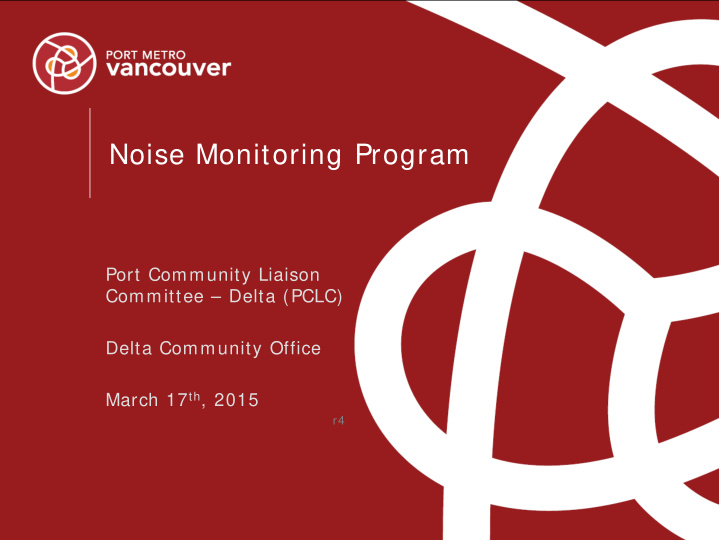



Noise Monitoring Program Port Community Liaison Committee – Delta (PCLC) Delta Community Office March 17 th , 2015 r4 portmetrovancouver.com portmetrovancouver.com
Noise Monitoring Program – Overview Program Goals Monitoring Locations - Delta Noise Sentinel System Noise Metrics I ntegration w ith Port Operations portmetrovancouver.com 2
Noise Monitoring – Goals • Noise is an important issue for the Port • Community complaint driven (current approach) • Part of Port’s sustainability objectives • Improve understand of noise environment • Confirm or exclude noise sources • Long term trending of port related noise • Establish a body of knowledge to inform decision makers portmetrovancouver.com 3
Roberts Bank Delta – Locations RBD Longhouse (TBC) RBD Tug Basin RBD Gingell Park Disclaim er: Levels indicated at noise terminals may not directly relate to community portmetrovancouver.com 4 or individual impacts as noise levels shown maybe mitigated or enhanced by environmental factors such as distance, physical structures, and weather
Noise Sentinel – Hardw are • Equipment supplied by Weather Brüel & Kjær Station • Integrated monitoring terminal Wireless Connection • Weather station option • Secure wireless data Solar Panel transmission • Managed 24 x 7 Microphone • Real-time web access • On-demand enquiry and Integrated reported for PMV Meter operational staff portmetrovancouver.com 5
Noise Sentinel – Public Portal http: / / www.portmetrovancouver.com/ en/ environment/ initiatives/ noise-monitoring http: / / portmetrovancouver.pmv.noisesentinel.com/ portmetrovancouver.com 6
Sound – Propagation Perception • Human Response • Relative to Other Sounds • Changes Over Time SOURCE Characteristics • Continuous PROPAGATI ON • Intermittent • Impulsive I nfluenced by • Tonality RECEI VER • Distance • Low Frequency • Atmospheric Conditions • Obstacles/ Barriers • Reflection/ Absorption portmetrovancouver.com 7
Sound – Basics Environm ental Noise • Relates to ambient sound levels beyond the comfort levels caused by traffic, construction, industrial, and some recreational activities . Sound Level (typically reported as L eq A) • A measure of sound pressure that is frequency-weighted (representing human response) and time-averaged (combining short term measurements to get longer term averages) for the purposes of reporting in the units of decibels (dB). Long Term Measurem ent • Most relevant to port related activities. portmetrovancouver.com 8
Sound – Long Term Metrics • Track number of noise events • Community Noise Equivalent Level (CNEL) • Annual time averaging • Adjustments accounting for sound characteristics Characteristic Factor Adjustm ent Evening (7 pm – 10 pm) + 5 dB Nighttime (10 pm – 7 am) + 10 dB Weekend, daytime (7 am – 7 pm) + 5 dB Regular impulsive + 5 dB Highly impulsive + 12 dB Tonal quality + 5 dB Low frequency Calculated dB Source: ANSI S12.9 Quantities and Procedures for Description and Measurement of Environmental Sound – Part 4 : Noise Assessm ent and Prediction of Long-term Community Response portmetrovancouver.com 9
Com m unity Port Operations I m pacts Continued Port Growth and Increased Activity Operational Anticipated Requirem ents • Strategy (in development phase) • Project and environmental review • Lead pilot projects • Collaboration with stakeholders portmetrovancouver.com 10
Questions Environmental Programs EnvironmentalPrograms@portmetrovancouver.com portmetrovancouver.com
Recommend
More recommend